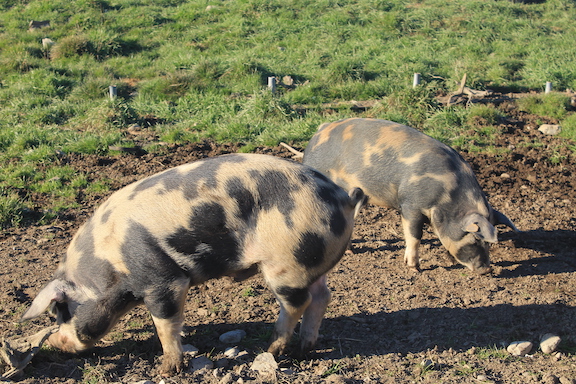By Jacki Martinez Perkins, MOFGA’s Organic Dairy and Livestock Specialist
The production of pork in Maine looks very different from other parts of the country. Being geographically distant from slaughterhouses with high capacity throughput as well as grain sources requires most local producers to manage their hogs creatively. Additionally, raising livestock capable of eating a varied diet lends itself well to a diversified, organic farm system.

Anyone that has tried relying less on the grocery store by growing their own food understands that a farmer’s knowledge of natural systems needs to run deep for them to be successful. Integrating pigs into a healthy farm system has many benefits that are being realized by Maine producers. Our topsoils aren’t deep, making the need to add fertility pivotal to robust production of vegetation. There are currently no affordable fertility resources for organic farmers besides those that livestock create. For land that needs to be renovated and fertilized, pigs are a valuable resource.
When pigs are stocked on pasture densely enough, producers aiming to reseed an area are able to reduce the impact from diesel-consuming, heavy farm equipment. Growing pigs, in search of protein sources and mental stimulation, will efficiently root the soil to the extent that a farmer may need only to harrow a field before planting, skipping the steps of spreading manure and plowing. This ultimately helps to reduce the deep compaction referred to as hardpan that farmers have struggled with since tractors gained popularity.
In addition to fast fertility in the form of feces, swine are able to convert waste from other parts of our farming systems into dense packages of fat and protein. One pig, when consumed with intention (and some quality recipes), can help to feed a family for a year. One sow, being very prolific, can produce pork for a community. A pig population left unchecked would quickly become a destructive and dangerous invasion to our ecosystem.
This natural virility coupled with the intelligence of pigs, and a general demand for pork products, led producers to search for safer ways to keep them confined away from public spaces. Outdated beliefs have led to current infrastructure challenges within the pork industry. What was seen as innovative several decades ago is in fact cruel, and in turn costly. There are now numerous studies of livestock that show comfortable and content livestock have healthier immune systems and growth curves. Removing sows from gestation crates is just the beginning of ending the cruelty.
Recently, a proposed rule change to the USDA’s National Organic Program (NOP) aims to specifically outline expectations from organic livestock and poultry producers. The proposed Organic Livestock and Poultry Standards (OLPS) was written to replace the rejected Organic Livestock and Poultry Practices (OLPP) rule from 2017. The OLPS does, in fact, better define conditions that hogs are allowed to be kept in, and attempts to walk a line between existing, larger scale infrastructure systems and smaller, 100% pasture-based systems. However, MOFGA feels there are shortcomings and oversights in the proposed rule and has provided comments on these for the NOP to review.
In the end, keeping livestock in a system that aligns with their natural behaviors while keeping them safe from predation and injury has benefits we humans haven’t even imagined.
This article was originally published in the winter 2022-23 issue of The Maine Organic Farmer & Gardener.
